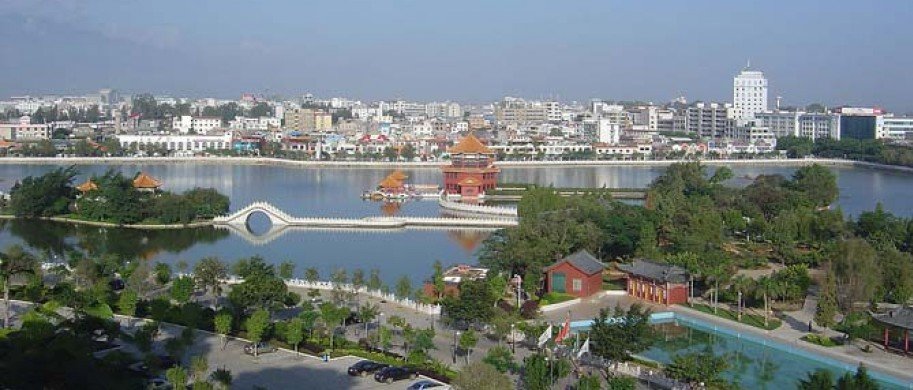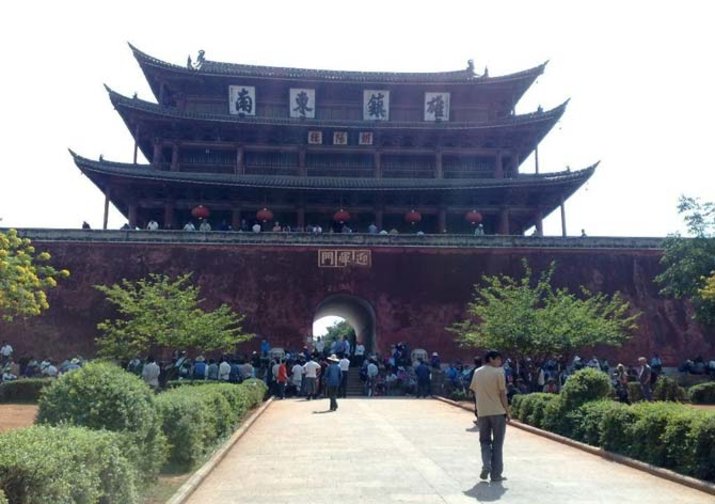
Honghe Hani and Yi Autonomous Prefecture is an autonomous prefecture in the southeast of Yunnan Province. Its name is derived from the Hong He ("Red River") and the two major ethnic minority groups who live there: the Yi and the Hani. Honghe has an area of nearly 33000 km². The capital of the prefecture is Mengzi.
In 2008, the State Administration of Cultural Heritage of the People's Republic of China nominated the Honghe Hani Terraced Fields of Yuanyang County for World Heritage Site status.
The Yi People
The Yi people, the older name "Lolo" or "Luǒluǒ" is now considered derogatory in China, though used officially in Vietnam as Lô Lô and in Thailand as Lolo [โล-โล]) are a modern ethnic group in China, Vietnam, and Thailand. Numbering 8 million, they are the seventh largest of the 55 ethnic minority groups officially recognized by the People's Republic of China. They live primarily in rural areas of Sichuan, Yunnan, Guizhou, and Guangxi, usually in mountainous regions. There are 3,300 Lô Lô people (1999 statistics) living in Hà Giang, Cao Bằng, and Lào Cai provinces in northeastern Vietnam.

The Yi speak Yi, a Tibeto-Burman language closely related to Burmese, which is written in the Yi script.

Religion
The Yi are animists, with elements of Daoism, shamanism and fetishism. Shamans/medicine men are known as “Bimo”, which means the master who can chant ancient documents. Bimo officiate at births, funerals, weddings and fetes. They are often seen along the street consulting ancient scripts. As animists, Yi worship the spirits of ancestors, fire, hills, trees, rocks, water, earth, sky, wind, and forests. Magic plays a major role in daily life through healing, exorcism, asking for rain, cursing enemies, blessing, divination and analysis of one's relationship with the spirits. They believe dragons protect villages against bad spirits, and demons cause diseases. However, the Yi dragon is neither similar to dragon in western culture nor the same as that in Han culture. After someone dies they sacrifice a pig or sheep at the doorway to maintain relationship with the deceased spirit.
The Nuosu religion (from the Nuosu or Nasu group in the Yi minority) distinguishes two sorts of shamans: the Bimo and the Sunyi. Bimo, who can read Yi scripts while Sunyi cannot, are the most revered and maybe also important agents in the Nuosu religion, to the point that sometimes the Nuosu religion is also called “bimo religion”. While one becomes a Bimo by patrilineal descent after a time of apprenticeship or formally acknowledging an old Bimo as the teacher, a sunyi must be elected. Both can perform rituals. But only Bimo can perform rituals linked to death. For most cases, Sunyi only perform some exorcism to cure diseases. Bimo are literate too. Generally, Sunyi can only be from humble civil birth while Bimo can be of both aristocratic and humble families. In order to preserve this heritage and promote tourism, the local government helped construct a museum to house ancient artifacts.

In Yunnan, some of the Yi have been influenced by Buddhism through the Han culture. The Yi believe in numerous evil spirits. They believe that spirits cause illness, poor harvests and other misfortunes and inhabit all material things. The Yi also believe in multiple souls. At death, one soul remains to watch the grave while the other is eventually reincarnated into some living form.
In the 20th century, some Yi people in China converted to Christianity, after the arrival of Gladstone Porteous in 1904 and, later, medical missionaries such as Alfred James Broomhall, Janet Broomhall, Ruth Dix and Joan Wales of the China Inland Mission. According to missionary organization OMF International, the exact number of Yi Christians is not known. In 1991 it was reported that there were as many as 150,000 Yi Christians in Yunnan Province, especially in Luquan County where there are more than 20 churches.

Location
Of the over 8 million Yi people, over 4.5 million live in Yunnan Province, 2.5 million live in southern Sichuan Province, and 1 million live in the northwest corner of Guizhou Province. Nearly all the Yi live in mountainous areas, often carving out their existence on the sides of steep mountain slopes far from the cities of China.
The altitudinal differences of the Yi areas directly affect their climate and precipitation. Their striking differences have given rise to the old saying that "the weather is different a few miles away" in the Yi area. This is the primary reason why the Yis in various areas are so different from one another in the ways they make a living.

History
Some scholars believe that the Yi are descended from the ancient Qiang people of today's western China, who are also said to be the ancestors of the Tibetan, Naxi and Qiang peoples. They migrated from southeastern Tibet through Sichuan and into the Yunnan Province, where their largest populations can be found today.
They practice a form of animism, led by a shaman priest known as the Bimaw. They still retain a few ancient religious texts written in their unique pictographic script. Their religion also contains many elements of Daoism and Buddhism.
Many of the Yi in Liangshan and northwestern Yunnan practiced a complicated form of slavery. People were split into thenuohuo or Black Yi (nobles), qunuo or White Yi (commoners), and slaves. White Yi were free and could own property and slaves but were in a way tied to a lord. Other ethnic groups were held as slaves.
Language
The Yi language belongs to the Tibeto-Burman branch of the Sino-Tibetan language family, and the Yis speak six dialects. Many Yis in Yunnan, Guizhou and Guangxi know the Han (standard Chinese or Mandarin) language. The Yis used to have a syllabic script called the old Yi language, which was formed in the 13th century. It is estimated that the extant old Yi script has about 10,000 mostly logographic characters, of which 1,000 mostly syllabic characters are of everyday use. A number of works of history, literature and medicine as well as genealogies of the ruling families written in the old Yi script are still seen in most Yi areas. Many stone tablets and steles carved in the old Yi script remain intact. Since the old Yi language is not consistent in word form and pronunciation, it was reformed after liberation for use in books and newspapers.[4]
Culture
The Yi play a number of traditional musical instruments, including large plucked and bowed string instruments,[5] as well as wind instruments called bawu (巴乌) and mabu (马布). Yi people's son's given name is patronymic, based on the last one or two syllable of father's name.
The Hani People
Hani people are an ethnic group. They form one of the 56 nationalities officially recognized by the People's Republic of China. They also form one of the 54 officially recognized ethnic groups of Vietnam. There are 12,500 Hanis living in the Lai Chau and Lao Cai provinces of Vietnam.
Over ninety percent of the Hani live in the southwestern Chinese province of Yunnan, scattered across the Ailao Mountains between the Mekong River and the Red River (Yuanjiang).
The origins of the Hani are not precisely known, though their ancestors, the ancient Qiang tribe, are believed to have migrated southward from the Qinghai-Tibetan plateau prior to the third century AD.
The Hani oral traditions state that they are descended from the Yi people, and that they split off as a separate tribe fifty generations ago. One of their oral traditions is the recital of the names of Hani ancestors from the first Hani family down to oneself.
Religion
The Hani are polytheists and they profess a special adoration toward the spirits of their ancestors. They are used to practicing rituals to venerate to the different gods and thus to obtain their protection.
The religious hierarchy of the Hani is divided into three main personages: the zuima that directs the main celebrations; thebeima, responsible for practicing the exorcisms and the magical rituals; the nima that takes charge of carrying out predictions and to administer the medicinal herbs. This last charge can be performed indistinctly by men and women. Some Hani also profess Theravada Buddhism.
Culture
The dwellings of the Hani are usually two or three stories high, built with bamboo, mud, stone and wood.
The traditional clothing of the Hani is used made out of dark blue fabric. The men dress in short jackets and in long wide pants. They also wear turbans which are white or black. The women dress depending on which clan they belong to. There is no gender difference in the clothing of children under the age of seven.
They play a wind instrument called the ebi.
Part of thousand years old culture are terraced fields.
Language
The Hani language spoken by many of the Hani is of the Yi branch of the Tibeto-Burman linguistic family. Oral tradition tells of an ancient written script, tradition says it was lost on the migration from Sichuan. They now use a romanization of the Luchun dialect as a written script.
(wikipedia)
- 421 reads
